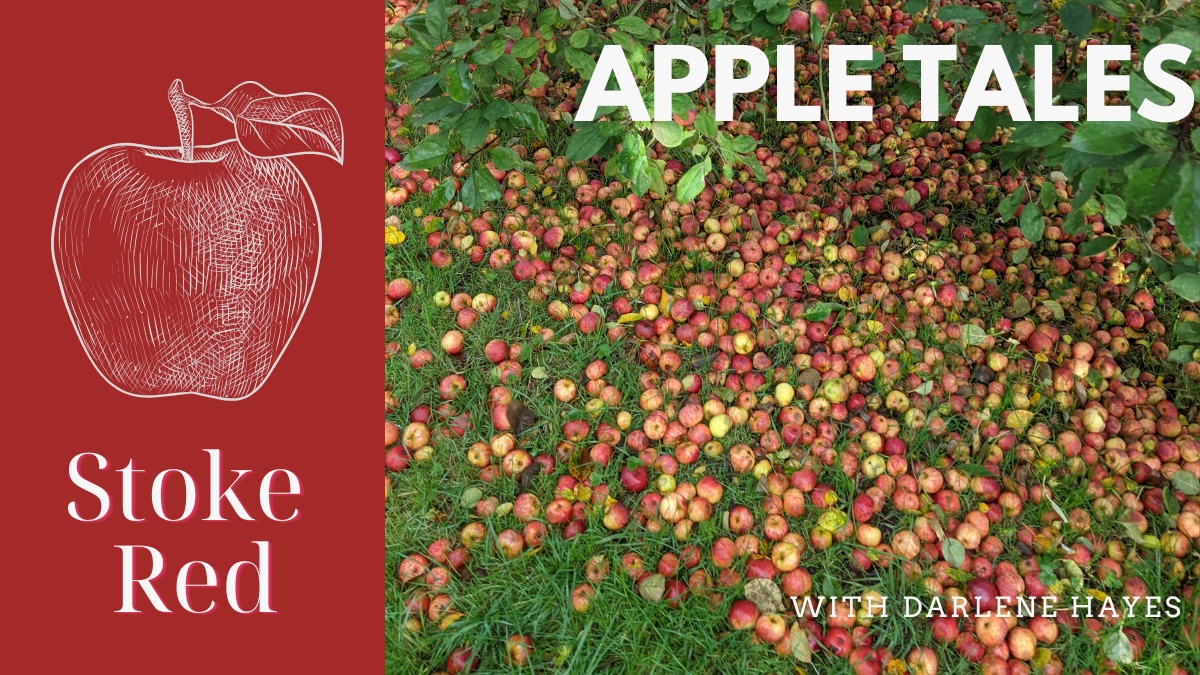Apple Tales with Darlene Hayes
Stoke Red never became the sort of household name that Kingston Black did, although it is a similar mild bittersharp. You won’t find old newspaper ads touting this variety, and there certainly aren’t the same number of single-variety ciders on the market. Yet dig a little deeper and it becomes clear that Stoke Red has its fans.
The first part of the 20th century was a time of great change in the cider world, particularly in the United Kingdom. Cider production went from being mostly farm-based and consumed locally to being big business, particularly after the founding of Bulmer’s Cider in the 1880s. Bringing cider into the industrial revolution was, of course, dependent on a reliable and ever-increasing source of apples to provide juice, and that was a problem. By the 1920s, there simply were not enough apples being grown for cider. Cider manufacturers had to increasingly rely on using culled market apples and imports from abroad, particularly France. While this worked well enough, the general feeling was that it would be better to ensure a robust domestic supply.
In the mid-twenties, the Long Ashton Research Station (LARS), which had been investigating growing apples for cider and the process of cidermaking itself, started a new competition. It was designed to focus on the quality of fruit, not the cidermaking. Participating farmers were instructed to ship about 1,700 pounds of a single variety of apple to the research station where the staff there made the cider using the same process for each of the entries. The categories were sharps (> 4.5 g/L acid), sweets (< 4.5 g/L acid), and bittersweets (< 4.5 g/L acid plus >2 g/L tannin), plus a separate category for the already famous Kingston Black.
In the second year of the competition, dairy farmer Herbert H. Sealy (1873-1939) sent a batch of Stoke Red, the first time it came to be noticed by the general public. Not only did it win first prize in the sharp category, but it thoroughly impressed the staff at LARS. The 1927 Annual Report of the Agricultural and Horticultural Research Station stated “this variety promises to be worthy of a place amongst the best sharp cider apples.” The next year’s report had similar praise: “This apple is undoubtedly an outstanding sharp variety.”
Stoke Red’s future was assured from this point forward.
Sealy lived and worked at Honeyhurst Farm just outside of Rodney Stoke, three miles from the town of Cheddar, home of the eponymous cheese that has been made there since the 12th century. Honeyhurst Farm was owned by the Tyleys, a family of wealthy yeoman that owned several farms in the area, including Manor Farm and Edgecomb. It is almost certainly one of the Tyleys that planted the original Stoke Red tree as the apple was well established there by the 1920s.
The staff at LARS was so impressed with the vintage quality of Stoke Red that they almost immediately began including it in their research. They grafted it into a number of test orchards and began using it to breed new varieties. It was a slow grower but was resistant to a number of troublesome orchard pests and a reasonably good pollinator for other varieties. When, in 1947, the LARS cider advisory committee published their short list of varieties recommended for planting, Stoke Red was on it.
Though Stoke Red’s unruly growth habit and small size — both of which demand extra labor — have made it a less popular choice for the modern orchard, its other positive characteristics have endeared it to some. One can find single-variety Stoke Red ciders on both sides of the Atlantic, though the ones made in the U.K. seem to come primarily from older orchards. Notes of orange and spice seem to be a common through-line, as is the abundant acid and tannin. These ciders did indeed have some similarity to a well-made Kingston Black, while at the same time maintaining their own unique character.
Bauman’s Cider – Gervais, OR
Dry; passion fruit, orange, lemon, tart apple, plum skin, leather, quince; sparkling
2021 | 7.9% ABV
Liberty Ciderworks – Spokane, WA
Dry; tart plum, twig, baked apple, clove, orange; sparkling
2017 | 7.5% ABV
Dragon’s Head Cider – Vashon Island, WA
Semi-dry; orange, orange peel, clove, ripe apple, plum skin, twig, baked apple; sparkling
Undated | 6.9% ABV
Dragon’s Head Cider – Vashon Island, WA
Dry; lemon, orange, plum skin, yellow apple, clove; sparkling
Undated | 6.3% ABV
Burrow Hill Cider – Kingsbury Episcopi, Somerset, U.K.
Dry; plum skin, apple, just ripe pear; sparkling
Undated | 8.0% ABV
Wilding Cider-#1 – Chew Magna, Somerset, U.K.
Semi-sweet; orange, ripe apple, wet leaves, twigs, peach, strawberry; sparkling
2020 | 3.8% ABV
Wilding Cider-#2 – Chew Magna, Somerset, U.K.
Semi-sweet; ripe apple, sweet orange, twig, ripe pear, clove, pear skin, rose; sparkling
2020 | 3.7% ABV
Oliver’s Cider and Perry – Ocle Pychard, Herefordshire, U.K.
Semi-sweet; sweet orange, orange blossom, ripe apple, clove, cinnamon, nutmeg, ripe plum, dried leaves; still
2015 | 5.5% ABV
Apple photo courtesy of Ross-on-Wye Cider Company.






